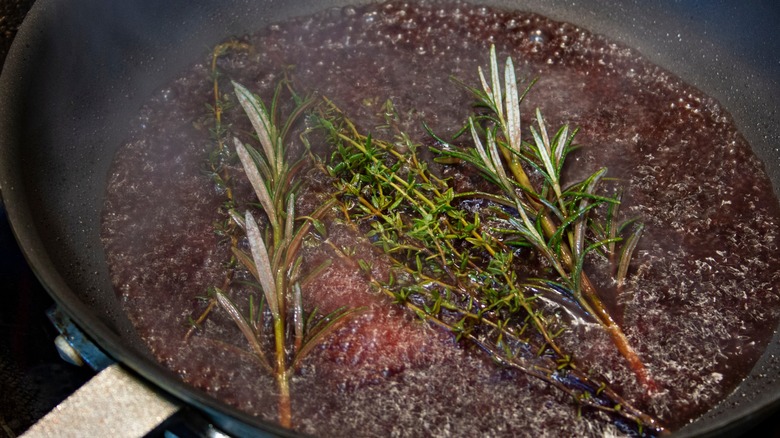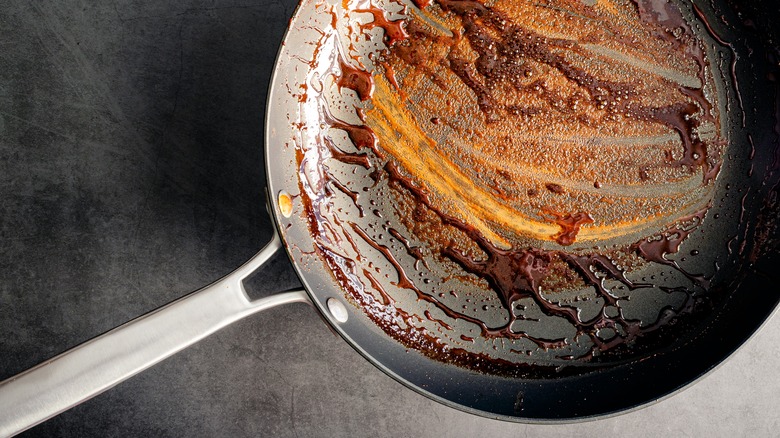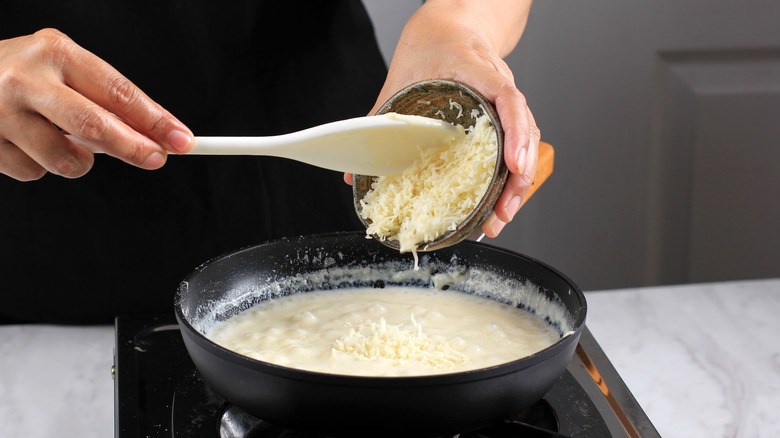Deglaze Pans With Coke And Vinegar For Alcohol-Free Wine Flavor
When you deglaze a pan, you're capturing the flavors that remain after cooking. This technique usually involves using an acidic liquid to blend the food left over from cooking, creating a tasty sauce. Deglazing also helps to lift tough and sticky bits, making it a useful technique for cleaning. Often, deglazing includes booze, which may not be your preference. Luckily, a simple two-ingredient recipe — including three parts Coke and one part red wine vinegar — can do the trick just as well. The caramelized sweetness of the Coke and the tangy acidity of the vinegar make for a flavor that's not too dissimilar to a wine-based pan sauce.
To prepare your deglazing liquid, you need to let your Coke decarbonate first. If you have a bottle, give it a good shake — then give it a minute to settle, remove the lid, and leave it to sit at room temperature. If you only have cans, decant them into a bottle and follow the same process. It takes roughly one to two days for carbonated drinks to go completely flat. However, as the cooking process will also speed up decarbonization, you can get away with using nearly flat Coke for this recipe too. After pouring out excess grease, add your deglazing liquid, keeping the heat medium to high. Use a wooden spoon to gently blend the mixture, and keep stirring until the liquid reduces to a glaze. You'll be left with a sweet, tart pan sauce, and a far easier washing-up job!
How to prep your pan for the best deglazing results sans booze
The best deglazing results begin with the right equipment: Use a stainless steel pan or cast iron skillet to achieve a fond in the cooking process. A fond is a layer of crispy remnants that cling to the bottom of a pan after cooking — an essential part of any deglazed pan sauce. Avoid nonstick pans, as they aren't designed to hold onto delicious flavor-packed morsels.
Once you've finished cooking your staple food items, whether they be steak, caramelized onions, chicken, or vegetables, transfer them out of the pan, but don't scrape away any charred bits or sticky areas, as these should be worked into the deglazing process. You can toss any burned or blackened fragments to avoid bitter flavors in your sauce.
Before you pour in your deglazing liquids, make sure you have the right amount of fat left in the pan. Too much will leave you with an overly greasy sauce, so aim for about a tablespoon, pouring out the rest. If you want an especially flavorful sauce, this is also the right time to add aromatics (like shallots, garlic, or onions) to the leftover fat. Caramelize them gently and slowly. You'll know it's time to add your deglazing liquids when the aromatics are soft and golden.
Take your pan sauce further with these creative techniques
Creativity is on the menu when making your deglazing mixture. Technically, you can deglaze with stock or even plain water. However, most recipes recommend using a blend that includes an acidic liquid. Popular choices include wine, vinegar, lime juice, or beer. Even orange juice is a game changer for deglazing pans.
Acidic liquids are a popular choice because adding something acidic to the pan can help balance a rich or oily sauce. To an acidic base, you can add a complementary flavorful liquid, such as any type of stock or broth — or Coke!
Choose additional ingredients to complement the flavor profile you're going for. For example, you can add whole or ground spices and herbs for an aromatic sauce, strawberry or raspberry jam to balance a salty protein, sweet honey or maple syrup for pork ribs, or creamy cheeses (like Gruyère or goat cheese) for a touch of luxury. Remember, if you're adding dairy, be sure to do so once your non-acidic pan sauce has cooled, or it may curdle.
You can thicken your pan sauce by adding a mix of flour and water. Combine two tablespoons of flour with ¼ cup of cold water for every cup of pan sauce. Blend the flour and water separately until it is smooth, and add it to your pan sauce while stirring. For a smoother result, strain your pan sauce through a sieve to eliminate any larger bits.



